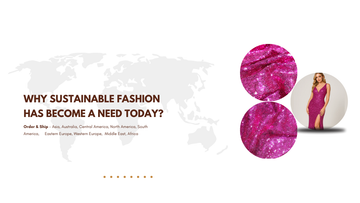Why Sustainable Fashion Has Become a Need Today
In recent years, sustainable fashion has transitioned from a niche trend to an urgent necessity. With growing environmental concerns, consumer awareness, and the fashion industry's significant ecological footprint, sustainable fashion offers a viable solution that benefits people and the planet alike.
Why sustainable fashion is essential today and how upcycling, deadstock materials, organic fabrics, and eco-friendly dyes are shaping this movement.
The Environmental Impact of Fast Fashion
The traditional fashion industry is one of the largest polluters globally. It contributes approximately 10% of global carbon emissions and is the second-largest consumer of water worldwide. For example, producing a single cotton shirt requires nearly 2,700 liters of water — enough for one person’s drinking needs for almost three years. Furthermore, the industry generates millions of tons of textile waste annually, much of which ends up in landfills or incinerators, leaching harmful chemicals into the environment.
Intricate threads & premium texture Printed Fabric
Creative, colorful & always trending Position Printed Fabric
Perfect alignment for standout looks Jacquard Fabric
Rich textures with woven luxury Plain Dyeable (RFD)
Customize colors, your way Pure Dyed Fabrics
Ready-to-stitch brilliance Designer Dupattas
From shimmer to sheer elegance Ready Stocks
Quick ship fabrics in bulk Kurti Fabrics
Comfort meets tradition New Arrivals
Fresh drops, every week
Fast fashion’s business model promotes rapid production and consumption of inexpensive clothes, resulting in overconsumption and significant waste. This unsustainable cycle not only depletes precious natural resources but also exploits labor and harms ecosystems worldwide. Hence, a shift toward sustainable practices is imperative.
What Is Sustainable Fashion?
Sustainable fashion refers to a holistic approach that prioritizes ethical production, environmental responsibility, and social equity. It encompasses the use of eco-friendly materials, reduction of waste, fair labor practices, and transparency throughout the supply chain.
This approach rejects the conventional “take-make-dispose” linear model in favor of a circular economy – emphasizing reuse, recycling, and reduced consumption.
Full-fabric luxury embroidery Sequins Embroidery
Shimmer & shine for every look Mirror Work
Traditional charm, modern edge Kali Embroidery
Panel-perfect precision Daman Embroidery
Statement borders for luxury finish Butti Embroidery
Elegant motifs, small & stunning Beaded Embroidery
Handcrafted elegance with sparkle Lace Embroidery
Soft, delicate & luxurious Schiffli Embroidery
Machine precision, classic style Hakoba Pre-Design
Ready-to-use placement patterns
1. Upcycling: Breathing New Life Into Old Materials
Upcycling is the creative reuse of old or discarded textiles and garments to create something new and valuable. Unlike recycling, which often breaks down materials into fibers, upcycling maintains the original material’s integrity, requiring less energy and resources.
Why Upcycling Matters:
-
Reduces Waste: It prevents textiles from ending up in landfills.
-
Saves Resources: It minimizes the need for virgin materials and lowers production footprints.
-
Encourages Creativity: Designers craft unique, one-of-a-kind products, adding artistic value.
Many fashion brands and independent designers now use upcycled fabrics to reduce environmental impact, offering consumers distinctive, sustainable alternatives to mass-produced garments.
2. Deadstock Materials: Sustainable Use of Surplus Fabric
Deadstock materials are leftover or surplus fabrics that would otherwise go to waste. Using deadstock fabric in fashion production prevents textile waste and extends the lifecycle of existing materials.
Benefits of Deadstock Fabric:
-
Waste Reduction: Prevents unused textiles from being discarded.
-
Cost Efficiency: Often cheaper than newly produced fabric.
-
Unique Designs: Deadstock fabrics are limited in quantity, resulting in exclusive pieces.
By choosing deadstock materials, brands reduce pressure on natural resources and promote zero-waste production.
3. Organic Fabrics: Eco-Friendly Textiles
Organic fabrics are grown without synthetic pesticides, fertilizers, or genetically modified organisms (GMOs), making them healthier for farmers, consumers, and the environment.
Explore Our Range of Premium Fabrics
- Viscose Muslin
- Viscose Organza
- Viscose Row Silk
- Natural Crepe
- White Cotton
- Kora Cotton
- Modal Satin
- Gaji Silk
- Linen Satin
- Bemberg Chiffon
- Dola Silk
- Upada Silk
- Nylon Chanderi
- Nylon Dhupian
- Satin Georgette
- Viscose Satin
- Tissue Anmol
- Tissue Gold
- Tissue Silver
- White Mull Cotton
- Santoon RFD Printed
- Russian Silk
- German Chiffon
- Row Silk Satin
Popular Organic Fabrics:
-
Organic Cotton: Uses less water and reduces chemical pollution compared to conventional cotton.
-
Hemp: Requires minimal water and enriches soil as it grows.
-
Linen: Made from flax plants, it is biodegradable and water-efficient.
-
Bamboo: A fast-growing grass processed into fabric with lower environmental impacts.
Organic fabrics promote sustainable agriculture and offer durable, breathable textiles that consumers increasingly prefer.
4. Eco-Friendly Dyes: Coloring Without Harming the Planet
Traditional dyeing techniques use toxic chemicals that pollute water bodies and harm aquatic life. Eco-friendly dyes offer safer alternatives, including natural plant-based dyes and low-impact synthetic dyes.
Types of Eco-Friendly Dyes:
-
Natural Dyes: Derived from plants, roots, flowers (e.g., indigo, madder, turmeric).
-
Low-Impact Synthetic Dyes: Require less water and energy, with reduced toxic effluents.
-
Digital Printing: Minimizes waste and energy consumption compared to conventional printing.
Choosing eco-friendly dyes reduces water pollution and helps maintain healthier ecosystems.
The Growing Demand for Transparency and Ethical Practices
Consumers today want to know the story behind their clothes – who made them, where, and how. This demand has pushed brands to adopt transparent supply chains, ethical labor practices, and certifications like GOTS (Global Organic Textile Standard).
The increase in conscious consumerism means supporting brands that prioritize workers’ rights and environmental stewardship is no longer optional but vital.
Steps You Can Take as a Consumer
-
Choose Quality Over Quantity: Invest in timeless, durable pieces over fast fashion trends.
-
Opt for Certified Sustainable Brands: Look for certifications like GOTS, Fair Trade, and OEKO-TEX.
-
Embrace Secondhand and Upcycled Fashion: Shop at thrift stores or brands that upcycle materials.
-
Care for Your Clothes: Wash less frequently, use cold water, and repair rather than discard.
A Sustainable Future for Fashion
Sustainable fashion is not just a trend but an essential movement towards a healthier planet and fairer livelihoods. Upcycling, deadstock materials, organic fabrics, and eco-friendly dyes are key components driving this transformation. By making informed choices and supporting sustainable practices, both consumers and brands can contribute to a more responsible and beautiful fashion industry.
------------------------------------------------------
FAQ
What is sustainable fashion?
Sustainable fashion is clothing produced with minimal environmental impact, ethical labor practices, and responsible resource use.
Why is sustainable fashion important?
It reduces pollution, saves resources, and promotes fair working conditions across the fashion industry.
What are deadstock materials in fashion?
Deadstock materials are leftover fabrics from factories or brands that are repurposed instead of being discarded.
How does upcycling help the environment?
Upcycling transforms old textiles into new products, reducing waste and conserving resources.
Are organic fabrics better for the planet?
Yes, organic fabrics are grown without harmful chemicals, using less water and promoting soil health.
What are eco-friendly dyes?
Eco-friendly dyes are natural or low-impact synthetic dyes that reduce water pollution and toxic waste.
How can consumers support sustainable fashion?
Buy quality over quantity, choose certified brands, and reuse or repair clothes instead of discarding them.






